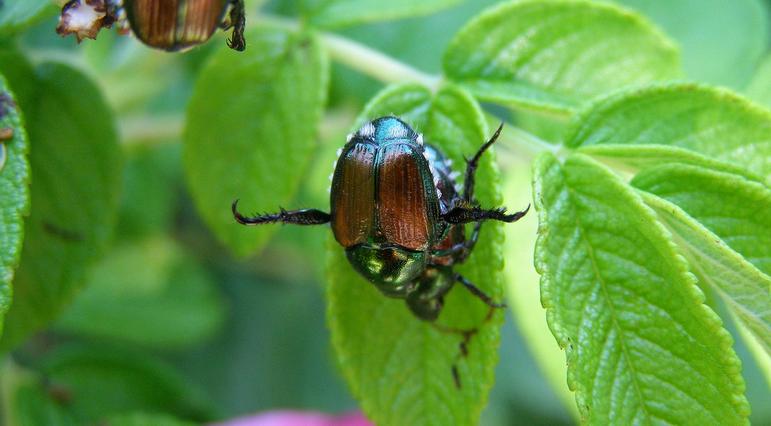Japanese Beetle Management

Japanese beetles have several stages in their life cycle and effective control targets each stage.
As gardeners we try very hard to keep our outdoor paradise insect and disease free. We also know we need to be on our toes at all times because pest outbreaks can occur out of the blue and can sometimes last for years. It seems if it’s not one thing, it’s another. For the past couple of years, Japanese beetles have been our nemesis.
I have seen some major infestations of Japanese beetles lately. I know people who have been trapping gallons of them a day. I’ve seen gardens completely destroyed by them. If you’re one of these gardeners, it’s time to prepare for battle because they’re going to be around for a while.
Japanese beetles don’t travel far from year to year, especially if they’ve found a favorable environment. They can fly as far as 5 miles, but most only wander 1 or 2. Usually they only make short trips from there favorite food sources. Local infestations spread as beetles are forced to move to favored food and egg- laying sites. If you’ve never had a problem with them in the past, but have been invaded by them this year, it’s probably because they were forced out of another area into yours.
First, we need to understand a little about the beetle’s life cycle. Let’s start with the adult stage since that is what we’re seeing now. The adults emerge out of the ground around the end of June and typically live for 45 days or so, although some adults can live into September. After emerging and feeding for a couple of days, the females leave to lay their eggs in the soil. The female lays about 1 to 5 eggs at a time. The female then goes back to feeding and mating, and this process continues until the female has laid about 40 to 60 eggs.
The eggs can hatch in as little as 9 days. The larva is a little grub that feeds on organic matter and fresh turf grass roots in the soil. The larva can do substantial damage to lawns. Once the temperatures dip, the grubs borrow deeper into the soil to hibernate. Around April they come out of their winter slumber and continue to develop and feed until the end of May. They then pupate and the adults emerge about 2 to 3 weeks later, around late June.
It is important to know the life cycle because this pest can cause damage in both the adult and grub stage, and control during both stages is more effective then control during just one. There are three main types of control we can focus on; cultural, mechanical, and chemical.
Cultural control has to do with controlling the environment, making it less appealing for both the adults and larva. For example, since both the eggs and larva don’t survive well in dry soil, don’t water your yard if at all possible. If you desire to have a lush, green lawn all summer long, you’re also creating a favorable environment for the eggs and larva. However, if we receive adequate rainfall, this tactic doesn’t work. If you live next to a golf course, or another area that gets watered frequently, you’re out of luck also.
Another cultural control is to stay away from planting the adult’s favorite foods near turf areas. Some of their favorite foods include Japanese and Norway maples, rose of Sharon, black walnut, fruit trees and flowering crabs, roses, mountain ash, lindens (basswood), birch, willows, Virginia creeper, and grapes and other small fruits. Although the adults will feed on 400 species of plants, if you can avoid their favorites, it helps a lot.
Mechanical control involves using traps. Although traps will collect large numbers of adults, remember it is also attracting large numbers also. Traps should be used in combination with other controls to be most effective. I advise using traps only after you notice you have a large population. If you put them out when you only notice a few, you will simply attract more.
Chemical control should be the last resort, but sometimes you have no other choice. There are products out there that will work for both the adults and the larva, but I suggest you talk to a professional at your local garden center to get the best advice. Products made with Carbaryl (Sevin®), acephate, cyfluthrin, and permethrin work against adults, and products containing Merit® work well against both adults and grubs. Mikly Spore is another product that can be used against the grubs. It is a bacterium that causes the grubs to stop feeding. The nice thing about Milky Spore is it continues to grow in the soil over time once applied, giving you control for years, and is organic and safe to use. Remember, always read the labels and follow instructions as given. Again, I can’t stress enough, talk to a professional to get the proper advice before using chemicals.
Now that you know a little more about the Japanese beetle and how to control, or at least manage, the population in your area, it will hopefully be less of an issue for you. If you make your yard less attractive to them, they’ll move on to greener pastures, literally.
--Mike Timm, horticulturist, Ebert's Greenhouse Village